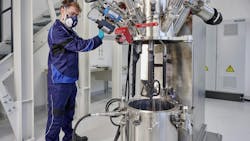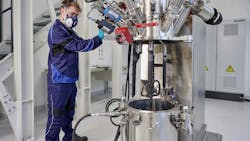Stir it Up: The Importance of Slurry Mixing in Batteries
In chemical and pharmaceutical processes, challenges such as avoiding agglomeration and settling of particles arise during the initial step of preparing the slurry for reaction, which typically involves precipitation. This step is crucial in process development. Similar issues are encountered in battery materials manufacturing, where effective anode and cathode slurry mixing is essential for optimal battery performance.
The mixing process must avoid agglomeration well as settling of the particles to prevent changes to their size distribution. Also, in some cases, solids are in the nanometer range, which can be difficult to mix. Additionally, battery processors must ensure they don’t damage the solids surface or create fines.
What is an Electrode Slurry?
An electrode slurry is a mixture of active material, conductive additives, solvents and binders. Battery processors apply this mixture onto copper and aluminum foil, followed by drying and calendaring, to form the cathode and anode in the battery cell.
The active materials are the reacting lithium ions, while the conductive additives facilitate the electron conductivity. For high-capacity lithium-ion batteries, it is important to optimize the ratio of active material to conductive additives. Each battery manufacturer balances these components to their own designs for optimum electron conductivity and minimal internal battery resistance.
Understanding Effective Slurry Mixing
Mixing is important to ensure there is maximum contact of the electrolyte and the active material to increase the ionic reaction and increase the battery capacity. With poor mixing, the conductive additive will not disperse, causing inefficient electron conduction. It also can lead to concentration of the charge, which would result in non-uniform battery reactions.
With poor mixing, the conductive additive will not disperse, causing inefficient electron conduction. It also can lead to concentration of the charge, which would result in non-uniform battery reactions.
Achieving proper mixing is not only essential for cost savings but also for optimizing battery capacity by reducing the proportion of conductive additives and increasing the active material content.
Additionally, achieving a homogeneous dispersion of the active material into the binder solution is crucial for ensuring consistent battery performance. The mixing process must not lead to the formation of agglomerates, as they can cause issues during coating operations. For example, the thin layers of the material range from 15-23 microns. If agglomerates change the coating reproducibility, the adhesion could change resulting in reduced battery capacity.
Mixing also is critical for the sedimentation stability of the slurry at low shear rates and low viscosity at high shear rates. The viscosity will be indicative of the dispersion efficiency of the components. These parameters will control the appropriate leveling and desired wet-layer thickness for the downstream coating process to ensure the optimum structure of the coated electrode layers and the battery performance.
Mixer Options
Battery processors typically use planetary mixers for electrode slurry mixing. For most applications, these mixers include two or three multi-hinged blades. The material flows up and down as well as around the inner cylinder when the paddles are moving in both revolution and rotation at the same time, which quickly produces the mixing effect. There are many blade-design options, which operators select based on viscosity testing results and coated-layer thickness reproducibility.
There are several newer alternatives to planetary mixers that are currently in the market. These have the benefits of continuous operation as well as being able to meet the dispersion requirements for nano-scale active material ingredients.
The planetary centrifugal mixer is a device that can agitate materials without using agitator blades. These mixers have a revolution with a centrifugal force, a rotation and a tilt resulting in a 3-D flow. It is also possible to operate the mixer under vacuum, which can improve the mixing results.
A second alternative is a thin-film spin high-speed mixer. In this operation, the thin-film spin design involves a high-speed revolution of the rotor, which causes materials to form a thin film along the walls of the vessel. The slurry is fed in from the bottom and discharged from the top or the side.
The choice of mixer depends upon the components to be mixed as well as the final properties of the type of lithium-ion battery, such as prismatic or pouch designs, solid-state, sodium-ion and lithium iron phosphate, to name a few. Regardless of the selected mixer, battery processors must measure the output quality of liquid density, solid density, shear rates, yield stress and thixotropic behaviors. This will optimize the mixing recipe, which processors can then correlate to the electric parameters of electrode sheets in the battery.
About the Author
Barry Perlmutter
President of Perlmutter & Idea Development (P&ID) LLC
Barry Perlmutter is president of Perlmutter & Idea Development (P&ID) LLC. He has over 40 years of science, engineering and business marketing experience in the field of solid-liquid separation including filtration, centrifugation, process drying, mixing and recycling. His strong professional skills focus on process and project solutions, innovation strategies and execution, market expansion and business development. Barry has published and presented worldwide on applications in the chemical, pharmaceutical, and energy/environmental industries and has been responsible for introducing many European technologies into the Americas marketplace. His two books, published by Elsevier, Amsterdam, "Handbook of Solid-Liquid Filtration" and "Integration & Optimization of Unit Operations" are used worldwide for process guidance.


